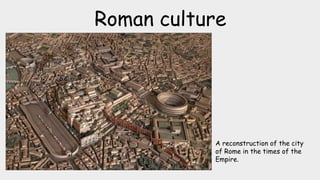
Roman culture
- 1. Roman culture A reconstruction of the city of Rome in the times of the Empire.
- 2. Architecture
- 3. The Roman forum. Each city had a forum. These are the ruins of the forum of the city of Rome. The forum was the centre of the city where the most important buildings were located: temples, libraries, amphitheatre, etc. On the right you can see the Palatine, one of the hills that surrounded Rome. Triumphal arches were built to commemorate important achievements of the Roman emperors or armies. The military parades after a victory took place in the forum. palatine
- 4. The forum was situated in the crossing of the two most important streets of a Roman city: the cardo maximus, and the decumanus maximus. This is the plan of the city of Barcino (Barcelona)
- 5. These are the ruins of the city of Tingad, in the North of Africa. You can see the cardo, the decumanus and the forum clearly.
- 6. The Romans were splendid architects. They built temples, palaces, bridges, amphitheatres, circuses,theatres, aqueducts... Temple of Diana in Mérida (Extremadura)
- 7. There were temples everywhere in the Roman dominions! This one in particular is in Armenia, far away from the capital, Rome. It is very well preserved.
- 8. One of the most important Roman temples is the Panteon in Rome. The Panteon is the place were all the Roman gods would be worshipped.
- 9. Mérida. Theatre. Like the Greeks, Romans enjoyed going to the theatre.
- 10. One of the most famous Roman buildings was the amphitheatre. It was used for gladiator fights, naval battles, fights with animals and the execution of prisoners. This is the famous Colosseum in Rome, the largest ampthitheatre.
- 11. Roman mosaics with gladiator scenes
- 12. Aqueducts were used to supply water to the cities. These are all Roman aqueducts: Nimes (France, left), Mérida (bottom left) and Segovia (bottom right)
- 13. This is how an aqueduct worked in the past, and the way water is supplied to cities in the present!
- 14. The Roman circus was used for chariot races. The ruins at the top are in Mérida They were very popular, and people bet for their favourite charioteer.
- 15. Sewers were important for big cities. This is the famous Cloaca Massima in the the city of Rome. It was built during the Monarchy, and it is still in use!
- 16. Bridges were very important for trade and the mobility of troops. This bridge is in Alcántara (Cáceres).
- 17. As you already know, roads were very important in Rome. Roads had four layers of different materials to make them more resistant. Below is a map with the most important Roman roads in Spain.
- 18. Roman baths were popular places for relaxing and meeting. This Roman baths are in the city of Bath, England.
- 19. Stadiums (like this one in Turkey) were used for all type of sporting events by the Romans.
- 20. Rich people lived in comfortable houses in the cities. These houses had gardens, kitchens, living rooms, bedrooms, etc. They were nicely decorated with paintings on the walls.
- 21. One of the important rooms of a Roman house was the triclinum. Here the owner of the house and his guests would have meals and fun. Romans did not eat sitting at a table, but reclining on pillows Slaves served the foods to their masters and the guests
- 22. The interior of the houses was heated with a heating system called the hypocaust. They heated the walls and the floors
- 23. The walls and the floors of many buildings were decorated with beautiful mosaics with very different themes: mythology, animals, geometric patterns, etc.
- 24. Some people (especially at the end of the Roman empire) lived in villas in the countryside. This is the villa of La Olmeda in Palencia, Spain.
- 25. In Rome most people lived in buildings called insulae. They had no running water or toilets, and they were not comfortable. Often several people lived in the same room, and would sleep on the floor.
- 27. Romans sculpted the portraits of people, especially emperors, patricians, military leaders, etc. Also, they made sculptures of gods and goddesses.
- 29. Paintings decorated the walls of the houses of the wealthy, and palaces.
- 30. Everyday life
- 31. Romans used all kind of objects. The pot at the top left was made in a refined way (terra sigillata). Luxurious items were made of silver, too. (bottom left) They also used utensils for cooking made in bronze, (bottom right) and glass (top right).
- 32. Oil lamps were used for illuminating the houses at night. Romans wrote on papyrus, or engraved stone and bronze tablets with texts. Children used these wax tablets for writing.
- 35. This is what a street could have looked like in Rome. Streets were mostly paved, and there were shops outside the buildings where people could buy jewelry, food, clothes, etc.
- 36. As many Romans did not have a kitchen at home, people usually ate in the taverns which were very popular.
- 37. These vessels were used to transport olive oil and wine on ships all over the Mediterranean
- 38. This is the fishery of Baelo Claudia in Cádiz. Here, Romans elaborated a famous sauce called garum, that was exported to other areas of the empire. Garum was used to mix with all types of foods, and it consisted of fish macerated with salt.
- 39. Romans used coins that were accepted all over the Empire. Most coins were minted in gold and silver, but in times of crisis they minted coins in bronze, but they had less value.